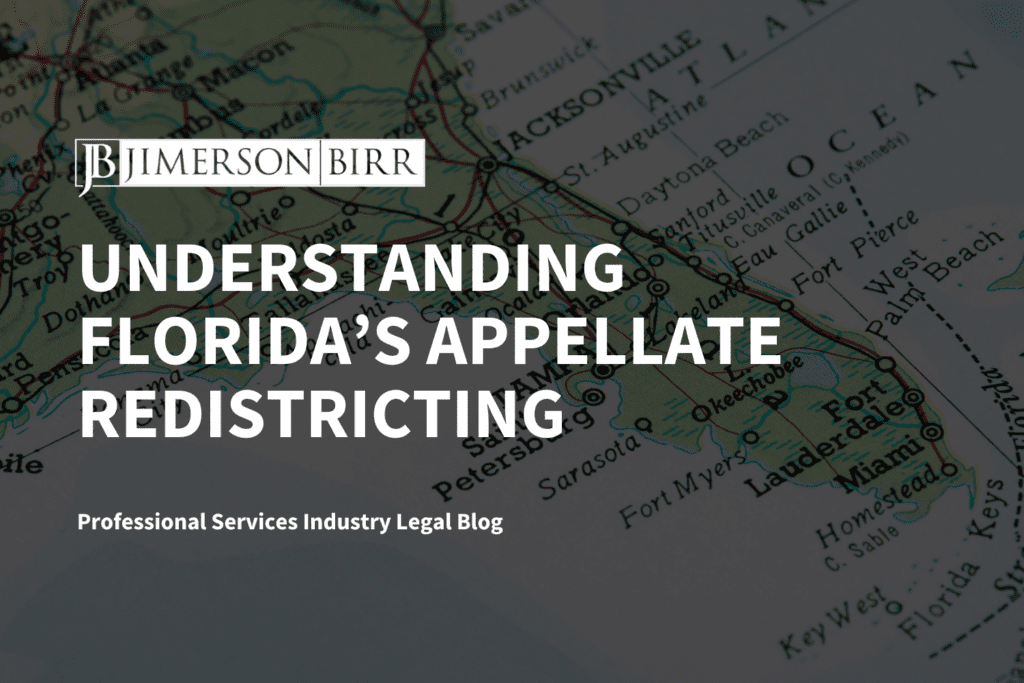On January 1, 2023, Florida took the historic step of creating a new Sixth District Court of Appeal. While the appellate redistricting might be easily dismissed by some as a legally nuanced change that only impacts practicing attorneys, the creation of the Sixth District is a major realignment of Florida’s courts that impacts caseloads and court operations in all matters litigated in the state. A new District Court of Appeal requires modifying existing boundaries of the appellate courts. Understanding this change—and the jurisdictional consequences—is critical for any business or individual considering taking their case to court.
Hierarchy of the Florida Courts
Understanding the appellate redistricting first requires a basic understanding of the structure of Florida’s judiciary. There are three levels to the Florida courts. Florida’s county and circuit courts are at the trial level. This is where the process begins and where a great number of cases will begin and end. Above the trial courts is the intermediate level where panels of 3 appellate judges sit and render decisions for the District Courts of Appeal. Above these district courts, and at the final level, sits the Florida Supreme Court. Florida’s appellate redistricting primarily affects the intermediate and trial court level but will nonetheless have far-reaching consequences for all litigants in the state.
The purpose of the District Courts of Appeal, or DCAs, is to provide an opportunity for comprehensive review of the trial court decisions and correct any harmful errors that may occur. Primarily, the DCAs will assess whether a trial court judge has abused his or her discretion or ensure that legal procedure was correctly followed and applied. In essence, the DCAs focus on the legal side of any case. DCAs will not reevaluate factual evidence.
It is important to be aware that DCA decisions represent the law of Florida. Pardo v. State, 596 SO. 2d 665, 666 (Fla. 1992). Trial courts are bound by the decisions of the district courts in which they are located. State v. Hayes, 333 So. 2d 51, 53 (Fla. 4th DCA 1976). Therefore, even if a party never gets to the appellate level, all Florida residents will be impacted by the decisions of the nine appellate judges currently sitting in the new judicial district.
Recent Appellate Redistricting
The last time Florida’s judiciary underwent such a seismic restructuring was over four decades ago with the creation of the Fifth District Court of Appeal in 1979. In re Redefinition of Appellate Districts and Certification of Need for Additional Appellate Judges, 20. 3d 703, 706 (Fla. 2021). Since then, Florida’s population has more than doubled. Florida’s judiciary aims to adapt to these changes.
To that end, former Chief Justice Charles Canady created the District Court of Appeal Workload and Jurisdiction Assessment Committee with representatives across all five of the then-existing DCAs. A majority of the committee determined a new DCA would boost citizen trust and confidence in the judiciary. The Florida Supreme Court adopted the committee’s work and recommendation in 2021. Quoting the committee, the Court wrote:
“Specifically, an additional [district court] would help provide adequate access to oral arguments and other proceedings, foster public trust and confidence based on geography and demographic composition, and attract a diverse group of well-qualified applicants for judicial vacancies including applicants from all circuits within each district.” Id. at 704.
In June of 2022, Governor DeSantis signed HB 7027 into law, officially creating the Sixth District. Since opening for business on January 1, 2023, the Sixth District has already become almost as busy as the other DCAs. The number of appeals and petitions in each DCA can be found on the appellate dashboard. Chief Judge Meredith Sasso has also already issued several administrative orders regarding briefing requirements, remote video oral arguments and the use of recording devices in the courthouse. See AO-23-01; AO-23-02; AO-23-05.
Results of Appellate Redistricting
The law did not just open a new Sixth District but also shuffled the trial courts and reorganized some of them into new or different DCAs. The DCAs sit in Tallahassee, Tampa, Miami, West Palm Beach, Daytona Beach, and Lakeland respectively, each covering multiple counties. The results of the reorganization can be found here.
- First District Court of Appeal – (1st, 2nd, 3rd, 8th, and 14th Circuits)
- Second District Court of Appeal – (6th, 12th, and 13th Circuits)
- Third District Court of Appeal – (11th and 16th Circuits)
- Fourth District Court of Appeal – (15th, 17th and 19th Circuits)
- Fifth District Court of Appeal – (4th, 5th, 7th, and 18th Circuits)
- Sixth District Court of Appeal – (9th, 10th, and 20th Circuits)
When DCAs disagree, the trial courts are bound by the decision of the district court they sit in. However, for a new Sixth District which may not have had an opportunity to stake out its own position on inter-district splits, the situation will be different. If the DCA in which the trial court sits has issued no decision, the trial court will be free to apply the precedent of whichever foreign district is so chooses. See Pardo, 596 So. 2d at 666. As a result, until the Sixth District takes a position, trial courts in the 9th, 10th and 20th Judicial Circuits will have greater liberty to pick between the decisions of other DCAs.
Take Away
Florida’s appellate redistricting represents a major change in how cases will be litigated and particularly will impact residents and litigants in DeSoto, Hillsborough, Manatee, Pasco, Pinellas and Sarasota County where the Sixth District sit. For any party considering litigation in Florida, it is important to be aware of the jurisdiction in which they reside as inter-district splits can result in different binding authority or law depending on the particular DCA’s decisions, or lack thereof.

